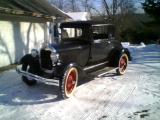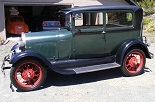|
|
#21 |
|
Senior Member
Join Date: May 2010
Location: Northeast Penna
Posts: 2,108
|
A little automotive history here...
From the beginning of Chrysler Corporation ( 1924 ) until the early 1950's, the companies cars were largely defined by their trio of lead engineers: Carl Breer, Fred Zeder, and Owen Skelton, whom Walter P. Chrysler liked to refer to as his "Three Musketeers". All three gentlemen had worked in the automotive industry since the early 1910's, and cut their teeth at firms such as Chalmers, Studebaker, and Packard, before joining forces under Walt Chrysler. By 1930, Chrysler Corporation was firmly established as one of the industry leaders. Always looking to improve the product, Carl Breer became focused on improving the speed and efficiency of Chrysler Corp autos. His team took some wooden and clay models of current production designs ( c. 1930, here, still in the "upright box" era), and placed them in a wind-tunnel, and measured air-flow and drag characteristics. They were a little surprised to find that the conventional closed-bodies of the time had less drag when placed rear-end first in the wind-tunnel. Further investigation and research led to a "streamlined" car project, the first prototype was a homely beast named the Trifon, around 1932. The end-result was indeed the Airflow line of unit-body, streamlined cars available in Chrysler and De Soto, from 1934-37. These vehicles had very respectable drag coefficients, even into the 1970's. Breer and co. continued to experiment with improving the Airflow's aerodynamic qualities, the most "slippery" being a version with a long, tapering tail, like an airplane fuselage. While it gave great performance numbers, it was deemed impractical as a production feature. Other variations included front-wheel drive versions, and a radial-engine version. After 3 years of dismal sales, Chrysler abandoned the Airflow line, and concentrated on building conventionally styled cars, since that's what the public seemed to desire, in spite of the Airflow's numerous engineering achievements. For anyone who wishes to learn more about the early auto industry, and the origins of Chrysler Corporation, I would recommend Carl Breer's memoir: "The Birth of Chrysler Corporation and its engineering legacy"; a really neat look into the first 50 years of the American auto industry. The "take-away" I get from the Airflow experiments is that the drag created by pre-1934-'35 auto bodies is not so much from the frontal area, but from the negative air pressure ( "vacuum" ) created by the abrupt end of the boxy sedan body... ( think of the turbulence immediately behind big boxy semi-trailer...). While the Airflow and similar cars did try to "soften" the front profile to reduce initial wind resistance, they definitely tapered the rear section of the body down gradually to minimize drag. Sorry I don't have any hard numbers or graphs, but some of the empirical / anecdotal information might be useful... After the Airflow, the next big winners in aerodynamic auto design were the step-down Hudson in 1948, and the Nash Ayrflyte in 1949.... |
|
|

|
|
|
#22 |
|
Senior Member
Join Date: May 2010
Posts: 447
|
This information is only loosely related to the subject, but about 10 years ago I made some calculations to compare Model A performance with and without an overdrive. The calculations required some assumptions, so the results are only approximate. The calculations assume that a stock engine is being used.
With an overdrive (Mitchell ratio), you will get better gas mileage below 53 miles per hour, but lower gas mileage above that speed. If the top speed of the car is 62 mph without overdrive, the top speed with overdrive would be 63 mph. My conclusion is that there is not much benefit having overdrive when operating at high speed. Many people claim that their car is much quieter with an overdrive, but the air noise from my '29 Tudor is such that I can hardly hear any engine noise when on the highway. |
|
|

|
| Sponsored Links (Register now to hide all advertisements) |
|
|
|
|
#23 |
|
Senior Member
Join Date: May 2010
Location: Fountain Valley, Calif.
Posts: 937
|
I have had a Mitchell in my 1930 Town Sedan for over 6 years now, and have gone on several tours with it, as well as lots of town and freeway driving in S. California. From my experience there is a very big difference in my restored car, from original to having the overdrive.....much quieter at 55-60 mph and obviously less strain on the engine. I have also gotten very good mileage when driving at a steady 60 mph on trips....not worse.
|
|
|

|
|
|
#24 |
|
Senior Member
Join Date: Oct 2012
Location: Whangarei, New Zealand
Posts: 298
|
Depends how you look at that.
At the same speed, the HP required to move the car is the same - you just have to make more HP per firing stroke at lower RPM.
__________________
Allan '29 Tudor, Canadian RHD Whangarei, NZ "Duct Tape can't fix stupid, but it can MUFFLE the sound" |
|
|

|
 |
«
Previous Thread
|
Next Thread
»
|
|
| Sponsored Links (Register now to hide all advertisements) |
|
|
All times are GMT -5. The time now is 01:10 AM.







 Linear Mode
Linear Mode

